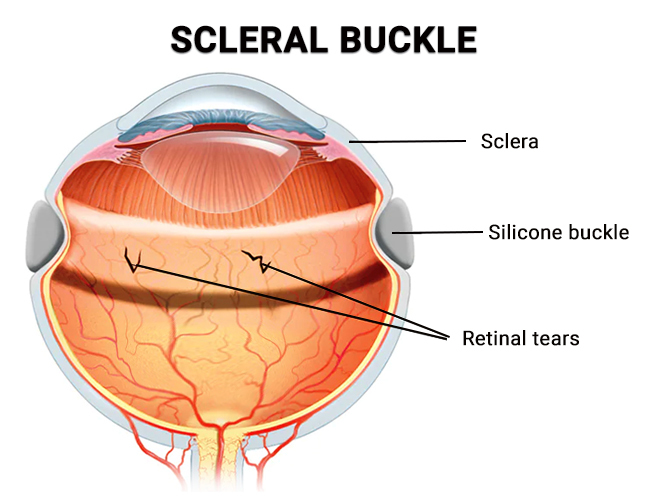 (212) 861-9797
(212) 861-9797
 (212) 861-9797
(212) 861-9797
A detached retina in one of your eyes is a medical emergency. Without prompt treatment, you can permanently lose sight in that eye. Turn to the most experienced ophthalmology practice in NYC: Vitreous Retina Macula Consultants of New York (VRMNY). These top-rated eye doctors rely on the latest medical technology to determine the exact diagnosis so they’re able to treat your vision problems and save your sight. A scleral buckle is a surgical procedure that helps maintain the position of your repaired retina. Your eye surgeon only performs it if you need it. So call the best ophthalmologists you can find, like those at VRMNY, when you start having problems with your vision. They’ll give you the care you need.
A scleral buckle is one of the surgical procedures used to treat a detached retina. The retinal detachment treatment procedure sometimes involves placing a semi-hardIf you have sudden vision pro silicone support around the outside of your eye. The buckle seals the retina to its proper position against the inside back wall of your eye. The three types of eye buckle include:
The retina is a sensory membrane at the back of your eye. Through its light-sensitive photoreceptor cells — called rods and cones — the retina receives and organizes visual information. Any damage to the retina, such as detachment, causes vision problems and requires immediate attention by a top ophthalmologist. Your eye doctor may leave the buckle in place for six months to 10 years, depending on the support your retina needs.

The scleral buckling procedure protects your vision by treating a detached retina. At Vitreous Retina Macula Consultants of New York (VRMNY), the talented retina specialists and ophthalmologists use this and other eye surgical or in-office, outpatient procedures to address eye issues. At their state-of-the-art facilities in Manhattan, Westchester and Brooklyn, the top eye doctors use the latest medical equipment, such as diagnostic imaging, to determine the cause of your vision problems and treat it.
Dr. Slakter and the team are the very best. They have been taking care of me for the last 15 years or so and it is really more than the outstanding medical specialty, which goes without saying. It is also the human care and personal consideration that makes me feel part of a team that really cares about me and all other patients equally!
MOSES D. GoogleA detached retina is an eye disorder that causes the retina in the back of your eye to pull away from its supporting tissues. This is an eye emergency that requires urgent attention to prevent permanent damage to your eye. Retinal detachment surgery is one of the more advanced procedures used to treat this serious eye condition. A detached retina can develop because of a serious eye injury, a retina tear, diabetes or eye inflammation. Symptoms of retinal detachment include:
If you notice any of these symptoms, consult an eye specialist at VRMNY for a diagnosis. These NYC eye doctors have years of experience in eye treatment research. In fact, they publish extensively on the subject. Besides scleral buckle eye surgery, the eye doctors perform other advanced eye procedures, including:
Scleral buckle surgery is a complementary procedure for various types of retinal detachment repairs. You may be a good candidate for this eye surgery if you:
Risk factors for retinal detachment — such as diabetes, advanced age and a previous cataract surgery — may make scleral buckle surgery necessary. Your eye doctor at VRMNY has access to advanced medical equipment for an accurate diagnosis and effective treatment, including a scleral buckle when needed.
The scleral buckling procedure takes one to two hours. Only an experienced, qualified retina specialist can perform this advanced procedure. The main steps in retinal detachment surgery include:
If you have sudden vision problems, including floaters in your eye, consult a top retina specialist at VRMNY. This is the most established eye care facility in New York City, with the equipment and personnel to perform the most complex eye surgeries. Contact an eye doctor today at VRMNY to protect your eyesight.
Let us help you enjoy your life
Call: (212) 861-9797To Speak With An Appointment Coordinator Now